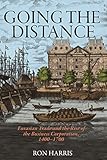Going the Distance : Eurasian Trade and the Rise of the Business Corporation, 1400-1700 / Ron Harris.
Material type: TextSeries: The Princeton Economic History of the Western World ; 88Publisher: Princeton, NJ : Princeton University Press, [2020]Copyright date: ©2020Description: 1 online resource (488 p.) : 28 b/w illus. 20 tables. 14 mapsContent type:
TextSeries: The Princeton Economic History of the Western World ; 88Publisher: Princeton, NJ : Princeton University Press, [2020]Copyright date: ©2020Description: 1 online resource (488 p.) : 28 b/w illus. 20 tables. 14 mapsContent type: - 9780691150772
- 9780691185804
- Corporations -- Europe -- History
- BUSINESS & ECONOMICS / Economic History
- Accounting
- Arabian Sea
- Arabs
- Armenians
- British Empire
- Business Activities
- Cairo Geniza
- Calculation
- Caravanserai
- Case study
- Central Asia
- Central Europe
- China
- Civilization
- Commodity
- Confucianism
- Corporation
- Creditor
- Currency
- Dividend
- Dutch East India Company
- Eastern Mediterranean
- Economic development
- Economics
- Entrepreneurship
- Ethnic group
- Eurasia
- Eurasian (mixed ancestry)
- Europe
- Exchange rate
- Exit Option
- Expense
- Expropriation
- Fugger
- Fujian
- Fustat
- General partnership
- Governance
- Guangzhou
- Gujarat
- Income
- Indian Ocean trade
- Indian Ocean
- Indonesia
- Infrastructure
- Institution
- Investor
- Islam
- Jews
- Joint venture
- Joint-stock company
- Jurist
- Legal history
- Levant Company
- Limited partnership
- Literature
- Livorno
- Lock-in (decision-making)
- Longevity
- Malabar Coast
- Merchant
- Middle East
- Mongols
- Muziris
- New Julfa
- North Africa
- Organizational structure
- Ottoman Empire
- Ownership
- Partnership
- Passive investor
- Payment
- Principal–agent problem
- Quanzhou
- Receipt
- Roman Law
- Routledge
- Shareholder
- Silk Road
- Song dynasty
- South India
- Southeast Asia
- Spice trade
- Sri Lanka
- Stock market
- Stock trader
- Supply (economics)
- Syndicate
- Tax
- Technology
- Trade route
- Turpan
- Usury
- Wealth
- Western Asia
- Western Europe
- Writing
- Yuan dynasty
- Zheng (state)
- Zheng He
- HD2844 .H37 2019
- online - DeGruyter
| Item type | Current library | Call number | URL | Status | Notes | Barcode | |
|---|---|---|---|---|---|---|---|
 eBook
eBook
|
Biblioteca "Angelicum" Pont. Univ. S.Tommaso d'Aquino Nuvola online | online - DeGruyter (Browse shelf(Opens below)) | Online access | Not for loan (Accesso limitato) | Accesso per gli utenti autorizzati / Access for authorized users | (dgr)9780691185804 |
Frontmatter -- CONTENTS -- ACKNOWLEDGMENTS -- NOTE ON THE USE OF CITY NAMES -- INTRODUCTION -- PART I. The Context: Geography, Historiography, Theory -- PART II.Organizational Building Blocks -- PART III. Long-Distance Trade Enterprises on the Eve of the Organizational Revolution -- PART IV. The Corporation Transformed: The Era of Impersonal Cooperation -- CONCLUSION: Institutional Migration and the Corporation -- NOTES -- BIBLIOGRAPHY -- INDEX
restricted access online access with authorization star
http://purl.org/coar/access_right/c_16ec
Before the seventeenth century, trade across Eurasia was mostly conducted in short segments along the Silk Route and Indian Ocean. Business was organized in family firms, merchant networks, and state-owned enterprises, and dominated by Chinese, Indian, and Arabic traders. However, around 1600 the first two joint-stock corporations, the English and Dutch East India Companies, were established. Going the Distance tells the story of overland and maritime trade without Europeans, of European Cape Route trade without corporations, and of how new, large-scale, and impersonal organizations arose in Europe to control long-distance trade for more than three centuries. Ron Harris shows that by 1700, the scene and methods for global trade had dramatically changed: Dutch and English merchants shepherded goods directly from China and India to northwestern Europe. To understand this transformation, Harris compares the organizational forms used in four major regions: China, India, the Middle East, and Western Europe. The English and Dutch were the last to leap into Eurasian trade, and they innovated in order to compete. They raised capital from passive investors through impersonal stock markets and their joint-stock corporations deployed more capital, ships, and agents to deliver goods from their origins to consumers. Going the Distance explores the history behind a cornerstone of the modern economy, and how this organizational revolution contributed to the formation of global trade and the creation of the business corporation as a key factor in Europe’s economic rise.
Mode of access: Internet via World Wide Web.
In English.
Description based on online resource; title from PDF title page (publisher's Web site, viewed 27. Jan 2023)


